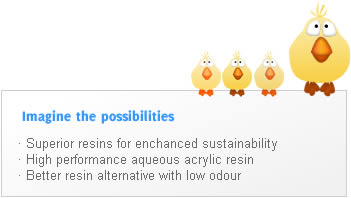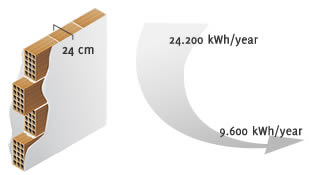Children's bedroom
Did you know ......indoor aor quality is considered safe when the volatile organic compounds (VOCs) levels does not exceed 200 μg/m3 of fresh air.
Building, furnishing and fresh air from chemistry
Powder coatings improve air quality
They are commonly used in key sectors such as aluminium window frames, household appliances and transport. They don't need liquids or solvents, are greatly effi cient, easy to use and environmentally friendly.
There is a great interest in the replacement of some petrochemical based chemicals with renewable feedstocks in a wide range of application areas.
The lower temperature cure, enabled by new biobased powder coating resins, represents a signifi cant achievement in saving energy and in reducing CO2 emissions.
ALBESTERTM Polyesters, Hexion
Less emissions from better building technology
New preservation technologies offer environmentally sound solutions for the in-can preservation of paints, binders and similar products. They efficiently avoid the growth of micro-organisms, even when there are aggravating factors such as humidity and high temperatures.
The new technology is effective at lower dosage than competitive products. Its formaldehyde free formula eliminates concerns about human health issues and it has no emissions of volatile organic components.
ROCIMA™, Rohm and Haas
Building the materials for your children's future
Environmentally-advanced resin solutions for building insulation

The thermoset binder is based on pure acrylic, water-based technology and has low odour like the new Aquaset™. This makes it of real benefi t to those involved in the manufacuring process and to the buidling owners and their families. This is a modern insulation tool.
Aquaset™, Rohm and Haas
Smart microcapsules regulate room temperature
Under the microscope, these microcapsules sparkle like jewels. It's their function, not their material value that makes them something special. As latent heat stores, these capsules make it possible to keep temperatures constant and smooth out peaks with no or strongly reduced air conditioning.
The perspex ("plexiglass") microcapsules -about 5 thousandths of a millimeter in diameter- contain a storage medium such as paraffi n. When the contents melt by higher room temperature, heat is taken up. When room temperature lowers again, heat is released when the material solidifi es. An interesting application for the tiny temperature managers is in offi ces and apartments.
Each square meter of Micronal® PCM gypsum wall board contains three kilograms of microencapsulated latent heat storers
Micronal PCM, Micronal PCM SmartBoard, BASF
Insulating better and new paints save energy
A new generation of insulation foams with nanometer-sized cells saves up to 50 % more energy
Heat is the result of collisions between gas molecules. If you can stop the molecules from colliding, much less heat can still be transported. The new generation of insulation foams will therefore have tiny cells of nanometer-scale, which corresponds to the mean free path of a gas molecule! This would bring the exchange of heat to a virtual standstill. The resulting foams would have thermal insulating properties similar to those of vacuum plates without the need to use a vacuum. This would improve the insulating performance of a foam by more than 50 % or reduce by more than half the material thickness required for a given insulating performance.
BASF I+D
Make waterborne paints live longer: stabilize them better
The role of light stabilizers is to signifi cantly reduce the photo-oxidation processes and their damaging consequences on paint fi lms. UV Absorbers (UVA's) prevent the degradation of clear top-coats, of base coats and also substrates by fi ltering the harmful UV energy of sunlight and converting it into harmless levels of heat.
A new range of stabilisers has been developed to make the incorporation of hydrophobic light stabilizers in waterborne paints simple and easy. Based on a patented encapsulationtechnique, the range consists of preparations where the actives are incorporated into acrylic particles easily dispersible in water and waterborne coatings. This example of sustainable innovation is not only an enabler for lower emission coatings, it also brings a signifi cant improvement in the durability and, hence, the service lifetimes of coatings.
TINUVIN®-DW range®, Ciba
One study of a detached house with walls 24 cm thick showed that an exterior insulation and fi nish system would cut the amount of heating-energy consumed from 24,200 kWh/year to 9,600 kWh/year over 40 years
This is equivalent to a saving of about 65,000 liters of oil. With that amount of fuel, a car could travel 830,000 km or 20 times around the world!

Aqueous paints reinvented
Because they contain no emission creating volatile organic compounds (VOC), aqueous paints make up the fastest growing segment of the industrial and decorative markets. But until recently, achieving a homogeneous dispersion of light stabilizers, essential for high quality paints, has been a real challenge in VOC free paint systems.
Novel Encapsulated Additive Technology (NEAT) allows hydrophobic light stabilizers to be easily and homogeneously dispersed in aqueous paints without using co-solvents and without requiring high energy dispersion equipment. An important contribution to the reduction of emissions to the atmosphere.
Ciba I+D